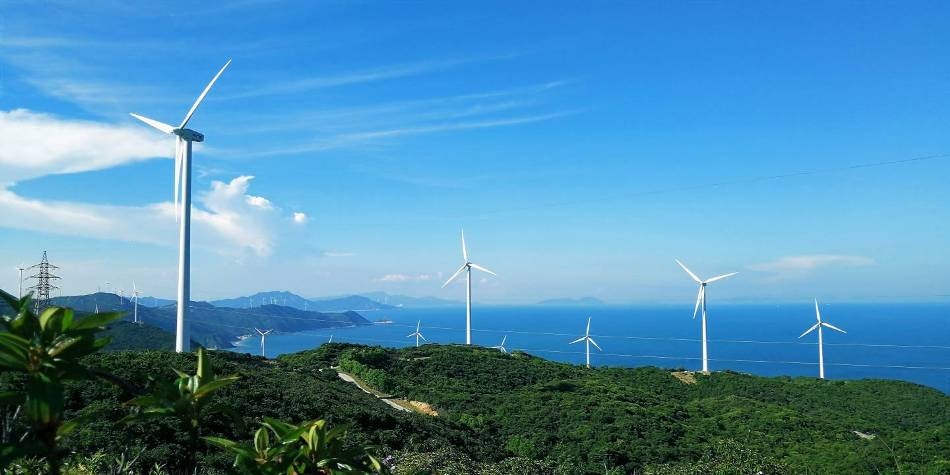Nov 19 2019
Average daily wind speeds are increasing across most parts of the globe after roughly three decades of steady slowing. This has turned out to be a blessing to wind farms. A study led by a research team at Princeton University reveals that there has been an increase in wind speeds in northern mid-latitude regions by approximately 7% since 2010.
 Research led by a team at Princeton University shows that wind speeds in northern mid-latitude regions have increased by roughly 7% since 2010, marking a reversal of the pattern of declining winds in these regions since the 1980s. The photo shows wind turbines in Ningbo, an area on China’s Pacific coast south of Shanghai. Image Credit: Erping Sun.
Research led by a team at Princeton University shows that wind speeds in northern mid-latitude regions have increased by roughly 7% since 2010, marking a reversal of the pattern of declining winds in these regions since the 1980s. The photo shows wind turbines in Ningbo, an area on China’s Pacific coast south of Shanghai. Image Credit: Erping Sun.
The study findings indicate a turnabout in the pattern of declining winds in these areas from the 1980s—an occurrence referred to as global terrestrial stilling. The scientists focused on regions of North America, Asia, and Europe where wind power is on the increase, analyzing wind speed records gathered between 1978 and 2017 from over 1,400 weather stations.
In a paper published in the November 18th issue of the Nature Climate Change, they demonstrated that there was a nearly 2.3% decrease in wind speeds per decade starting from 1978. Since 2010, wind speeds have picked up at a rate that is almost three times faster.
The research covered only regional averages and did not scrutinize how the uptick in wind speeds might have an impact on the harshness of storms, which has also been increasing.
According to Zhenzhong Zeng, the researchers analyzed the potential factors behind global terrestrial stilling and its reversal. While variations in vegetation and urbanization have been seen as contributors to global terrestrial stilling, these developments have not reversed since 2010. Zeng led the study as a postdoctoral researcher working with Eric Wood, Princeton’s Susan Dod Brown Professor of Civil and Environmental Engineering, Emeritus.
Zeng and his coworkers employed statistical approaches to test the link between differences in wind speed and an array of well-defined ocean-atmosphere oscillations. Ocean-atmosphere oscillations, which tend to change the distributions of pressure and heat, had long been assumed to stimulate ocean wind speeds. This study showed the global relationship between the oscillations and land-based wind speeds.
The study demonstrated that in each region of the globe, particular large-scale ocean-atmosphere oscillations, which are triggered by numerous factors, including the uneven heating of the Earth’s surface in various regions, were probable explanations for the noticed trends in wind speeds.
The team extended the findings to wind power generation, calculating that a standard wind turbine receiving the global average wind would have generated around 17% more energy in 2017 than in 2010. They used climate indices to predict future wind speeds, forecasting a 37% increase by 2024.
According to Zeng, wind speed trends may be responsible for a major portion of the increase in wind energy production efficiency in the United States from 2010 to 2017, whereas technological advances in wind turbines may have played a smaller role than is generally thought. At present, Zeng is an associate professor at the Southern University of Science and Technology in Shenzhen, China.
We predict that the increasing wind speed trend will continue for 10 years, but we also show that because this is caused by ocean-atmosphere oscillations, maybe a decade later it will reverse again.
Zhenzhong Zeng, Postdoctoral Researcher, Southern University of Science and Technology
Since the lifetime of a wind turbine is generally a maximum of 20 years, having dependable projections of wind speeds at specific locations could be vital to making smart investments in wind power and boosting the worldwide share of renewable energy.
Knowing about possible downtrends in wind speeds in the longer term can indeed be very useful for planning of future wind power infrastructure. This type of research, blending geosciences and engineering to elucidate phenomena of great societal significance, is timely and will increase our understanding of the close connections between climate and society.
Charles Meneveau, Professor in Mechanical Engineering, Johns Hopkins University
Charles Meneveau was not involved in the study.
Besides Wood and Zeng, scientists involved in the study included: Alan Ziegler, of the National University of Singapore; Timothy Searchinger, a research scholar at Princeton’s Woodrow Wilson School of Public and International Affairs; Long Yang of Nanjing University; Anping Chen of Colorado State University; Kunlu Ju of Tsinghua University; Shilong Piao of Peking University; Laurent Li of Sorbonne Université, Philippe Ciais of France’s Laboratoire des Sciences du Climat et de l’Environnement; Deliang Chen and Cesar Azorin-Molina of the University of Gothenburg; Junguo Liu of China’s Southern University of Science and Technology; Adrian Chappell of Cardiff University; and David Medvigy of the University of Notre Dame.
The study was supported partly by the Chinese Academy of Sciences, the Southern University of Science and Technology, and Lamsam–Thailand Sustain Development.